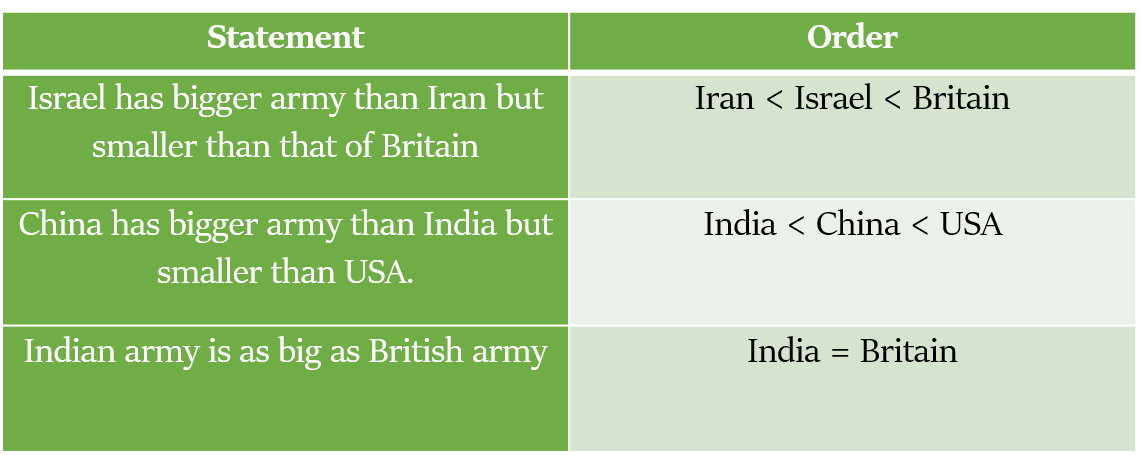Comparison and Ranking Question Types
In this article, we will have a look at the various types of Comparison and Ranking Puzzles that you may encounter in an aptitude examination.
Type 1
Q. Israel has a bigger army than Iran but smaller than that of Britain. China has a bigger army than India but smaller than that of USA. Indian army is as big as British army.
Which of the following countries has the second largest army?
(a) India (b) Israel (c) China (d) USA
Explanation:

Therefore, the order of the armies in ascending order:
Iran < Israel < Britain = India < China < USA
Thus, China has the 2nd largest army.
Answer: (c)
Type 2: Ratios given
Q. Read the following information regarding the ages of 4 persons A, B, C, D and answer the item that follows:
- A is 2/5th the age of B.
- C is 3/4th the age of D.
- A is 5/3rd the age of C.
Who is the youngest of them?
(a) A (b) B (c) C (d) D
Explanation:
Let the ages of A, B, C and D be a, b, c and d.
So, a = (2/5) b
or a : b = 2 : 5 = 10 : 25
Similarly, c : d = 3 : 4 = 6 : 8
And a : c = 5 : 3 = 10 : 6
Thus, a : b : c : d = 10 : 25 : 6 : 8
We can see that, B is the eldest and C is the youngest of them all.
Answer: (c)
Type 3: Puzzle Sets
Q. Read the following information regarding four boys, A, B, C and D, which are standing in a row according to their height, and answer the item that follows:
- Only one boy is taller than A
- C is not the shortest of all and B is not the tallest of all.
- D is not standing next to B
Choose the correct order of the heights of the four boys from the codes given below:
(a) D > A > B > C
(b) D > A > C > B
(c) C > A > B > D
(d) C > D > A > B
Explanation:
Let us assume that the boys are standing in a decreasing order of their heights from left to right.
According to statement 1, only one boy is taller than A. This means A is standing at the second position from the left.
– A – –
Now, C is not the shortest. Thus, C cannot be standing at the right extreme. And B is not the tallest, so he cannot be standing at the leftmost position.
Thus we get: D/C > A > B/C/D > B/D
Now, two cases are possible:
Case 1: D is the tallest and hence is standing at the leftmost position
D > A > C > B
Case 2: C is the tallest and hence is standing at the leftmost position
C > A > B/D > B/D
But according to statement 3, D is not standing next to B. Thus, case 2 is not possible.
Thus, order of the heights of the four boys is D > A > C > B
Answer: (b)
Alternate Method
Another way to solve this problem would have been to look at the options first and then eliminate those options that are not satisfying the given three conditions. It could be seen that only option (b) holds.